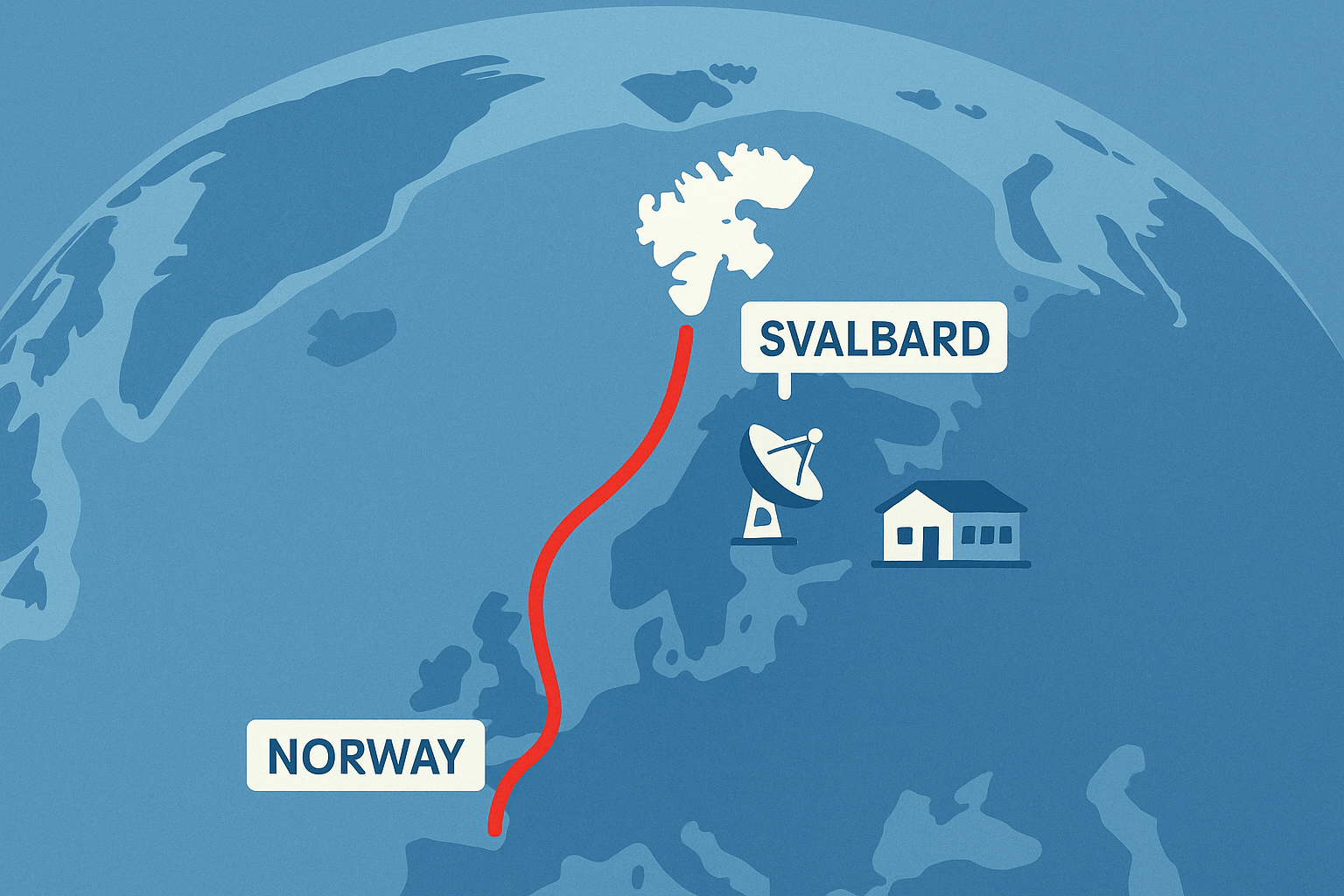A Lifeline Across an Arctic Seabed
To understand the cable’s importance, one must first appreciate the geography of Svalbard. This cluster of islands, crowned by glaciers and home to more polar bears than people, lies at a latitude of 78° North, halfway between mainland Norway and the North Pole. Its principal settlement, Longyearbyen, is the world’s northernmost town of any significant size. This extreme remoteness is its defining feature.
Until 2004, Svalbard relied on slow, low-capacity satellite links for its connection to the outside world. This was a major bottleneck. To solve this, Telenor laid two separate fiber optic cables stretching from Longyearbyen to Harstad in northern Norway. The decision to lay two cables was a crucial one, providing redundancy in one of the planet’s harshest marine environments. The seabed here is not a gentle slope; it is a complex landscape of trenches and ridges, and the cables must endure immense pressure, potential disruption from fishing trawlers, and the ever-present geopolitical tensions of the High North.
The Data Heart of Arctic Science
Svalbard’s unique location makes it a natural laboratory for Earth sciences. Longyearbyen and the research outpost of Ny-Ålesund host a dense concentration of international scientists studying everything from atmospheric physics to glaciology. This research generates an astronomical amount of data.
Consider the Kjell Henriksen Observatory, which studies the aurora borealis and the complex interactions between the sun and Earth’s upper atmosphere. Its sensitive instruments and powerful radars generate terabytes of data that cannot be stored locally. The undersea cable allows this data to be streamed in real-time to universities and processing centers around the world, enabling global collaboration and immediate analysis. Without this high-bandwidth connection, much of the groundbreaking climate and space weather research conducted on Svalbard would be impossible. It transforms the archipelago from an isolated data-collection point into a fully integrated node in the global scientific network.
Earth’s Window to the Cosmos: The Svalbard Satellite Station
Perhaps the most critical function of the Svalbard cable is serving the Svalbard Satellite Station, or SvalSat. Perched on a mountain plateau above Longyearbyen, its landscape of giant white radomes looks like a science fiction film set. Its location is its superpower.
Satellites in polar orbits circle the Earth from pole to pole. Because of the planet’s rotation, a ground station near the equator might only have a brief window to communicate with a specific satellite once or twice a day. But a station at a high latitude like Svalbard sees these satellites on almost every single one of their 14 daily orbits. This unique geographical advantage makes SvalSat the busiest and most important ground station in the world for downloading data from polar-orbiting satellites.
These aren’t just any satellites. They include:
- Weather Satellites: Providing crucial data for forecasting across Europe and North America.
- Earth Observation Satellites: Including the EU’s Copernicus program, which monitors sea ice, deforestation, oil spills, and the effects of climate change.
- Scientific Satellites: From NASA, the European Space Agency (ESA), and others, studying everything from ocean currents to gravity fields.
SvalSat acts as a colossal data funnel, downloading incredible volumes of information on each pass. But this data is useless if it’s “stuck” in the Arctic. The undersea cable is the firehose that blasts this vital planetary information to the mainland in milliseconds, where it is processed and distributed to governments, agencies, and scientists globally. In this sense, the cable doesn’t just connect Svalbard; it connects our view of the entire planet from space.
A Strand of Sovereignty in a Complex Geopolitical Sea
The Svalbard cable’s importance transcends science and technology, entering the realm of geopolitics. The archipelago operates under the unique terms of the 1920 Svalbard Treaty, which grants Norway sovereignty but gives citizens of signatory nations (including Russia, China, and the US) the right to reside and conduct commercial activities there.
In this internationalized environment, physical infrastructure is a powerful statement. The cable is a tangible assertion of Norwegian sovereignty. It makes Norway the indispensable gatekeeper for the vital data flowing out of the archipelago. Any nation conducting research or operating satellites via Svalbard is ultimately reliant on this Norwegian-owned infrastructure.
This reliance also highlights a critical vulnerability. In January 2022, one of the two fiber optic cables went out of service. While the cause was never definitively established, the event sparked intense speculation about potential sabotage amidst heightened tensions in the Arctic. The incident was a stark reminder that this single data link is a strategic asset and a potential target. In an era where the “Great Game” between global powers is increasingly being played out in the High North—over shipping routes, resources, and military positioning—control over data infrastructure like the Svalbard cable is a key element of national security and influence.
More Than Just Glass and Light
The Svalbard Undersea Cable is far more than a simple communications wire. It is a scientific artery, pumping lifeblood data from the front lines of climate change research. It is a strategic nerve, controlling our eyes in the sky and relaying a real-time portrait of our planet. And it is a political anchor, securing a nation’s sovereign foothold in one of the world’s most sensitive and rapidly changing regions. Buried in the cold, dark silence of the Arctic Ocean, this cable is a silent testament to how modern geography is defined not just by land and sea, but by the invisible flows of data that connect, empower, and define us.
